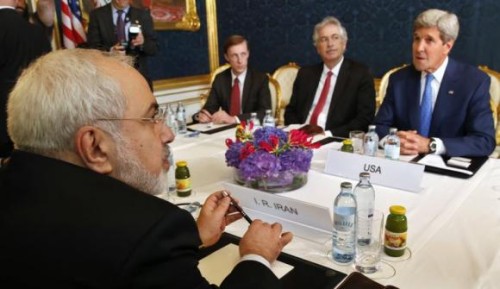On Friday, Iran and the 5+1 Powers (US, Britain, France, Germany, Russia, and China) announced that they would not reach agreement on a comprehensive nuclear deal by Sunday, when an interim agreement expired.
However, the two sides — who had been in discussions in Vienna since July 2 — said they would extend the interim arrangements for four months while a resolution was sought.
All delegations spoke of a “good atmosphere” and “progress” in the 16 days of negotiations; however, all also said “significant gaps” remained on key issues.
What are those key issues?
Most media accounts only referred generally to divisions over Iran’s centrifuges for enrichment of uranium; however, the veil of secrecy over the discussions was lifted a bit by reports from Julian Borger of The Guardian and by Iran’s Mehr News Agency.
Here’s what we know — and what is still unclear:
HOW MANY IRAN CENTRIFUGES? AND HOW ADVANCED CAN THEY BE?
What is Agreed: Both sides agreed in November’s interim deal that Iran would halt production of 20% enriched uranium, converting its existing stock to oxide power or diluting it to 5%.
What is Disputed:
Iran currently has 19,000 centrifuges, about half of which are operational, for production of 5% uranium.
The key outcome for Iran is not the number of centrifuges but their output of “Separative Work Units”. The regime’s objective, revealed by the Supreme Leader two weeks ago, is 190,000 SWUs.
Those SWUs can be achieved by a combination of two steps:
1) Increasing the number of centrifuges
2) Putting in advanced models — Iran is currently using 40-year-old IR-1m centrifuges. It installed IR-2 centrifuges in January 2013 but has not put them into operation.
Iran says it can reach 190,000 SWUs within several years with only 10,000 centrifuges; however, these must be not only IR-2s but yet-to-be-developed IR-4 models.
The US and European partners have publicly insisted that Iran must reduce its number of operational centrifuges, and they have refused any possibility of the use of IR-2s, let alone development of IR-4s.
Developments Borger’s account, posted just before the adjournment on Friday, is the most detailed look behind the secrecy of the talks.
The journalist says that US Secretary of State John Kerry raised the number of centrifuges that could be accepted from 1,500 to 6,000.
The Iranians did not compromise on the number of centrifuges, but offered assurances such as conversion of uranium to oxide powder, preventing potential use in a militarized nuclear program. They also emphasized that the escalation of output did not have to occur immediately — loosely described as a “freeze” by Western media — but could occur over a number of years.
Critically, Borger only talks about the number of centrifuges and never mentions discussion on their level. Iran’s Mehr also simply mentions disagreement about “enrichment amount and capacity”.
So we are still in the dark as to whether the US and Europe have made any concession to allow the operation of IR-2 and IR-4 centrifuges, a prerequisite for a deal if Iran is not allowed to expand its stock.
WHAT IS THE DURATION OF THE AGREEMENT?
What is Disputed: Entering the latest round of talks, the US and European partners said they wanted a lengthy agreement of 10-15 years.
Iran, resisting any long-term arrangements restricting developing of nuclear capability, said the duration should be 5 years.
Developments: Borger indicates that, far from closing the gap, the US widened it during the talks — Kerry linked the “concession” on number of centrifuges to “a minimum 20-year lifespan” for an agreement.
THE ARAK HEAVY-WATER REACTOR
While the centrifuge issue is the main one standing in the way of a deal, difficulties also seem to have arisen over the Arak heavy-water nuclear reactor, which Iran has scheduled for launch at the end of 2014.
Before and during the talks, Tehran signalled that it would meet Western concerns over the reactor’s plutonium by-product, which could be used in a military program. It said it would re-design the plant to reduce the by-product by up to 80%.
However, Borger indicates that the 5+1 Powers want a reduction of about 90%. Mehr quotes Iranian Deputy Foreign Minister Abbas Araqchi:
80% of the talks concerned enrichment and the Arak complex.
Iran offered several solutions for the Arak heavy-water reactor but the sextet (5+1) accepted none. The 5+1 suggested other choices.

